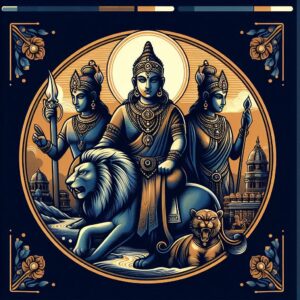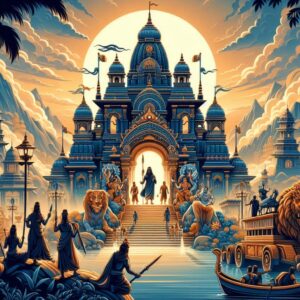At the time of Alexander’s invasion in 326 BC, Dhananand was the ruler of Magadha and there was no war between Alexander and Dhananand. But due to this invasion, unrest arose in the North West Frontier Province, to inform about which Acharya Vishnugupta/Kautilya/Chanakya of Takshila came to Pataliputra. Chanakya and Dhananand met in a Yagyashaala and Dhananand insulted Chanakya and Chanakya took a vow to completely destroy the Nanda dynasty. Chandragupta Maurya was bought from a hunter for 1000 Karshapal (silver coins) after seeing him playing a game called Rajkilam (King’s Justice). After this, Chandragupta Maurya was taken to Takshila with him and taught him politics and military skills, and in 322 BC, he invaded Magadha in which Dhananand’s commander Bhaddashal was killed.

Sources of information
1. Archaeological sources-
- NBPW (Northern Black Painted Ware) obtained from Ganga River Valley
- Inscriptions of Chandragupta Maurya and Ashoka
- Junagadh inscription of Ruddaman (Guj.)
2. Literary sources
- Jain texts, Buddhist texts
- Chanakya’s Arthashastra
- Mudrarakshasa of Visakadutta
- Kalhan’s book Rajatarangini
- Harshcharit by Banbhatta
- Indica of Megasthenes
- Details about Greek writers
Chandragupta Maurya [322-98 BC]
Historians have different opinions about the caste of Mauryas – Mauryas have been called Shudras in the Puranas. Vaishakhadatta has called Chandragupta Maurya a Vrishal i.e. of a low caste in Mudrarakshas. But in reality, Mauryas were Kshatriyas and residents of Pippalivan (Nepal). They were called Mauryas because they reared peacocks. Chandragupta Maurya has also been mentioned in Greek literature. Strabo and Justin have written about Chandragupta Maurya by the name of Sandrocottus, and Arrian and Plutarch have written about him by the name of Androcottus. William Jones was the first to confirm that the ruler mentioned in Greek literature was Chandragupta Maurya. Justin called Chandragupta’s army a gang of robbers. Plutarch has written that with an army of 6 lakhs, Chandragupta Maurya had blocked the entire Jammu Island (India). Chandragupta Maurya had conquered South India, which is mentioned in the texts named Ahananur and Murananur. In 305 BC, Chandragupta Maurya fought a war with the Greek ruler Seleucus Nicator in which Chandragupta was victorious. Seleucus handed over his daughter Helena’s hand to Chandragupta Maurya and gave 4 provinces as dowry – Aria (modern Herat – Afghanistan), Arachosia (present Kandahar – Afghanistan), Peripamisdai (Kabul – Afghanistan) and Zedrosia (Baluchisthan). Chandragupta gifted 500 elephants to Seleucus. Seleucus had sent Megasthenes to the court of Chandragupta Maurya. This war treaty and marriage have been mentioned by Appianus and Vishakhadatta in Mudrarakshasa. Two inscriptions of the time of Chandragupta Maurya have been found – Mahasthan (Bangladesh) and Sauhgaura (UP)
Sohgaura:
This is a copper instrument. Both the inscriptions mention famine whereas Megasthenes has said that there were no famines in India. The Junagadh inscription (Gujarat) of 150 AD of Shaka ruler Rudradaman has been found. This is the first inscription written in Sanskrit language. It is written in it that Pushyagupta Vaishya, the governor of Saurashtra province during the time of Chandragupta Maurya, had constructed the Sudarshan lake at a place called Girnar by stopping the water of Palashini and Swarn Sikta rivers originating from Urjayant and Raivataka hills and during the time of Ashoka, Tushasf was the governor here who had built a dam on this lake. In his last days, Chandragupta Maurya adopted Jainism and went to Shravanabelagola (Karnataka) with Bhadrabhahu. There is no mention of the places conquered by Chandragupta Maurya, but Bindusara did not conquer anything and Ashoka conquered only Kalinga, that is, all the places from where Ashoka’s inscriptions have been found were conquered by Chandragupta Maurya. Smith has written about Chandragupta Maurya’s empire that “Chandragupta had achieved that scientific and geographical boundary for which even the British had struggled in the 19th and 20th centuries”.

Bindusara [213-15 B.C.]
Bindusara’s mother’s name was Durdhara. Helena poisoned her while she was pregnant. Chanakya saved Bindusara by performing surgery. In Jain scriptures, Bindusara has been called Sinhasen, in Puranas, it has been called Bhadrasar, Greek writers have called it Amitrekotas and Patanjali has called it Amitraghat (destroyer of enemies). During the time of Bindusara, the ruler of Syria was Antiochus-1 who had correspondence with Bindusara. Bindusara had demanded three things from Antiochus: figs, wine, and philosophy. Antiochus sent Diamachus to the court of Bindusara with figs and wine and told him that philosophy is not bought or sold in our kingdom. Their conversation was recorded by Athenaeus. The Egyptian ruler Ptomeli-2 Philadolfus sent Dionysius to the court of Bindusara. Pliny writes that by the time Dionysius arrived, Bindusara had died and Magadha was ruled by Ashoka. Acharya Pingalvatsa of the Ajivika sect used to reside in the court of Bindusara who had predicted about Ashoka becoming the ruler. Bindusar’s son Susima was the governor of Taxila and Ashoka was the governor of Ujjaini. There were two rebellions in Taxila. The first time Ashoka was sent against the rebellion. Bindusar had declared Susima as his successor.
Also Read Part 2 – Click Here